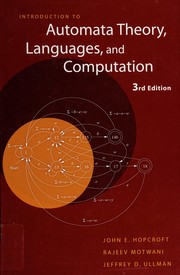Check nearby libraries
Buy this book

"This classic book on formal languages, automata theory, and computational complexity has been updated to present theoretical concepts in a concise and straightforward manner with increased coverage of practical applications. This third edition offers students a less formal writing style while providing the most accessible coverage of automata theory available, solid treatment on constructing proofs, many figures and diagrams to help convey ideas, and sidebars to highlight related material. A new feature of this edition is Gradiance, a Web-based homework and assessment tool. Each chapter offers an abundance of exercises, including selected Gradiance problems, for a true hands-on learning experience for students."--BOOK JACKET.
Check nearby libraries
Buy this book

Previews available in: German English
Subjects
Computational complexity, Formal languages, Machine theory, Programmeren (computers), Computers, Langages formels, Automates mathématiques, Théorie des, Complexité algorithmique, Langage formel, Formele talen, Lenguajes formales, Théorie des automates, Automate mathématique, Teoría de las máquinas, Cellulaire automaten, Complexité de calcul (Informatique), Artificial intelligence, Mathematical theory of computation, Computers - General Information, Computer Books: General, Computer Science, Logic, Computers / Computer Science, Programming languages (electronic computers), Computer mathematics, Mathematical programming & operations research, Komplexitätstheorie, Formale sprache, Automatentheorie, Qa267 .h56 2007, 511.3/5, St 130, Dat 500f, St 136, Dat 517f, Dat 550f, Dat 555fShowing 8 featured editions. View all 8 editions?
| Edition | Availability |
|---|---|
|
1
Introduction to automata theory, languages, and computation
2007, Pearson/Addison-Wesley, Pearson/Addison Wesley
Hardcover
0321455363 9780321455369
|
aaaa
Libraries near you:
WorldCat
|
|
2
Introduction to Automata Theory, Languages, and Computation (3rd Edition)
July 8, 2006, Addison Wesley
Hardcover
in English
- 3 edition
0321455363 9780321455369
|
zzzz
Libraries near you:
WorldCat
|
|
3
Introduction to Automata Theory, Languages, and Computation
2003, Pearson Education, Limited
in English
0321210298 9780321210296
|
zzzz
Libraries near you:
WorldCat
|
|
4
Einführung in die Automatentheorie, Formale Sprachen und Komplexitätstheorie
2002, Pearson Education Deutschland
in German
- 2., überarbeitete Auflage
3827370205 9783827370204
|
zzzz
Libraries near you:
WorldCat
|
|
5
Introduction to automata theory, languages, and computation
2001, Addison-Wesley
in English
- 2nd ed.
0201441241 9780201441246
|
zzzz
Libraries near you:
WorldCat
|
|
6
Introduction to automata theory, languages, and computation
1999, Addison-Wesley
in English
020102988X 9780201029888
|
eeee
|
|
7
Introduction to automata theory, languages, and computation
1998, Addison-Wesley
in English
020102988X 9780201029888
|
eeee
Libraries near you:
WorldCat
|
|
8
Introduction to automata theory, languages, and computation
1979, Addison-Wesley
in English
020102988X 9780201029888
|
eeee
Libraries near you:
WorldCat
|
Book Details
Table of Contents
Edition Notes
Classifications
Contributors
The Physical Object
ID Numbers
Community Reviews (0)
Feedback?History
- Created September 12, 2010
- 19 revisions
Wikipedia citation
×CloseCopy and paste this code into your Wikipedia page. Need help?
| September 24, 2024 | Edited by MARC Bot | import existing book |
| February 25, 2024 | Edited by OL-00 | Edited without comment. |
| December 19, 2023 | Edited by ImportBot | import existing book |
| October 20, 2023 | Edited by Drini | Fix TOC |
| September 12, 2010 | Created by C. A. Russell | Added new book. |


















